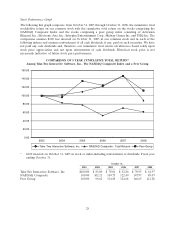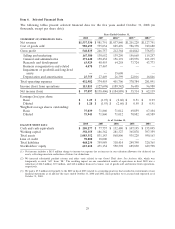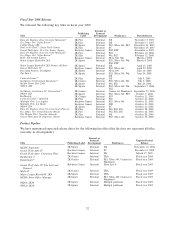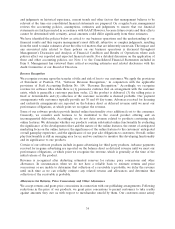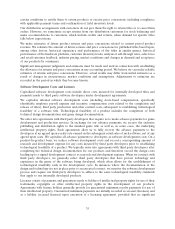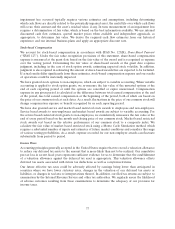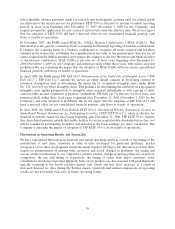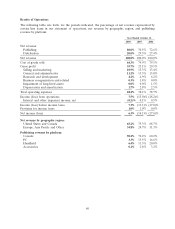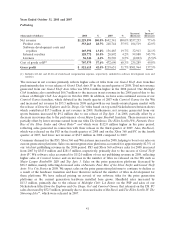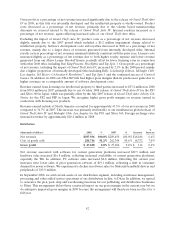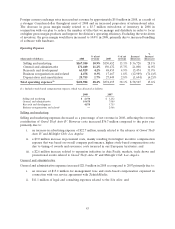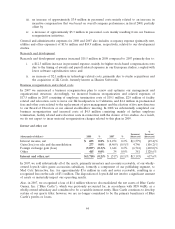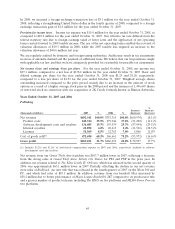2K Sports 2008 Annual Report Download - page 47
Download and view the complete annual report
Please find page 47 of the 2008 2K Sports annual report below. You can navigate through the pages in the report by either clicking on the pages listed below, or by using the keyword search tool below to find specific information within the annual report.impairment has occurred typically requires various estimates and assumptions, including determining
which cash flows are directly related to the potentially impaired asset, the useful life over which cash flows
will occur, their amount and the asset’s residual value, if any. In turn, measurement of an impairment loss
requires a determination of fair value, which is based on the best information available. We use internal
discounted cash flow estimates, quoted market prices when available and independent appraisals, as
appropriate, to determine fair value. We derive the required cash flow estimates from our historical
experience and our internal business plans and apply an appropriate discount rate.
Stock-based Compensation
We account for stock-based compensation in accordance with SFAS No. 123(R), Share-Based Payment
(‘‘SFAS 123’’). Under the fair value recognition provisions of this statement, share-based compensation
expense is measured at the grant date based on the fair value of the award and is recognized as expense
over the vesting period. Determining the fair value of share-based awards at the grant date requires
judgment, including, in the case of stock option awards, estimating expected stock volatility. In addition,
judgment is also required in estimating the amount of share-based awards that are expected to be forfeited.
If actual results differ significantly from these estimates, stock-based compensation expense and our results
of operations could be materially impacted.
We have granted stock options to non-employees, which are subject to variable accounting. When variable
accounting is applied to stock option grants, we re-measure the fair value of the unvested options at the
end of each reporting period or until the options are cancelled or expire unexercised. Compensation
expense in any given period is calculated as the difference between total earned compensation at the end
of the period, less total earned compensation at the beginning of the period, both of which are based on
the price of our common stock at such dates. As a result, fluctuations in the price of our common stock will
change compensation expense or benefit recognized by us each reporting period.
We have also granted service and market based restricted stock awards to employees and non-employees.
Service based awards to non-employees and market based awards are subject to variable accounting. For
the service based restricted stock grants to non-employees, we cumulatively remeasure the fair value at the
end of every period based on the month end closing price of our common stock. Market based restricted
stock awards vest based on the relative performance of our common stock to a composite index. We
calculate the fair value of market based restricted stock using a Monte Carlo Simulation method, which
requires a substantial number of inputs and estimates of future market conditions and considers the range
of various vesting probabilities. As a result, expense recorded for our non-employee awards can fluctuate
substantially from period to period.
Income Taxes
Accounting principles generally accepted in the United States require that we record a valuation allowance
to reduce our deferred tax assets to the amount that is more likely than not to be realized. Our cumulative
pre-tax loss in recent fiscal years represents sufficient evidence for us to determine that the establishment
of a valuation allowance against the deferred tax asset is appropriate. This valuation allowance offsets
deferred tax assets associated with future tax deductions as well as carryforward items.
Our future effective tax rates could be adversely affected by earnings being lower than anticipated in
countries where we have lower statutory rates, changes in the valuation of our deferred tax assets or
liabilities, or changes in tax laws or interpretations thereof. In addition, our filed tax returns are subject to
examination by the Internal Revenue Service and other tax authorities. We regularly assess the likelihood
of adverse outcomes resulting from these examinations to determine the adequacy of our provision for
income taxes.
37



